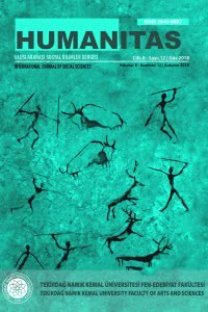Zaman, Mekân, Beden ve Öznelerarası Düzlemde Sanatçının Bir Genç Adam Olarak Korkusu
Duygular üzerine yapılan birçok çalışmada, araştırmacılar bazı temel duyguların var olduğu savını ortaya atmıştır. Bu temel duyguların sayısı en az dört olarak belirlenmiştir ve bunlar mutluluk, kızgınlık, üzüntü ve korkudur. Diğer tüm duygular, bu dört ana duygu üzerine kuruludur. Bu çalışmada, fenomenolojik çerçeve kullanılarak, öncelikle öznenin varoluşunun bir parçası olan zaman, mekân, beden ve öznelerarası boyutlar tartışılacak, ardından korku duygusunun bu dört düzlemde nasıl deneyimlendiği ve hissedildiği incelenecektir. Ayrıca, bu düzlemlerin, korku duygusunun oluşumunda ne tür bir role sahip olduğu ve korkunun hissedilmesi esnasında bu düzlemlerin korku duygusuna kapılan birey tarafından deneyimlenmesinde hangi değişimlere uğradığı, James Joyce’un Sanatçının Bir Genç Adam Olarak Portresi adlı romanında Stephen’ın yaşadığı iki olay üzerinden tartışılacaktır.
Anahtar Kelimeler:
James Joyce, Sanatçının Bir Genç Adam Olarak Portresi, korku, zaman, mekan, beden, öznelerarasılık
Fear of the Artist as a Young Man in Time, Space, Body and Intersubjective Dimensions
In most studies on emotions, researchers have proposed that there are some primary emotions. The number of these basic emotions is said to be at least four and they include happiness, anger, sadness, and fear. All other emotions build on these four primary emotions. In this study, first, by employing a phenomenological framework, time, space, body, and intersubjective dimensions which are part and parcel of the self’s existence will be discussed, and then how the emotion of fear is experienced and felt in these four dimensions will be analyzed. Furthermore, what role these dimensions have in the formation of fear and what changes they undergo during the experience of fear will be examined with reference to two incidents that befall Stephen in James Joyce’s A Portrait of the Artist as a Young Man.
Keywords:
James Joyce, A Portrait of the Artist as a Young Man, fear, time, space, intersubjectivity,
___
- Bernet, R., Kern, I., ve Marbach, E. (1999). An introduction to Husserlian phenomenology. Evanston: Northwestern University Press.
- Carman, T. (1999). The body in Husserl and Merleau-Ponty. Philosophical Topics, 27(2), 205-226. Clark, T. (2002). Martin Heidegger. London: Routledge.
- Coelho, N. E. ve Figueiredo, L. C. (2003). Patterns of intersubjectivity in the constitution of subjectivity: Dimensions of otherness. Culture and Psychology, 9(3), 193-208.
- Ekman, P. (1992). Are there basic emotions?. Psychological Review, 27(3), 550-553.
- Ekman, P., Sorenson, E. R., ve Friesen, W. V. (1969). Pan-cultural elements in facial displays of emotions. Science, 164, 86-88.
- Emotion. (t.b.). American psychological association dictionary of psychology içinde. https://dictionary.apa.org/emotion
- Guignon, C. (1993). Introduction. C. Guignon (Ed.), The Cambridge companion to Heidegger içinde (s. 1-41). Cambridge: Cambridge University Press.
- Heidegger, M. (2018). Varlık ve zaman (K. Ökten, Çev.). İstanbul: Alfa. (Orijinal çalışma basım tarihi 1927)
- Husserl, E. (1989). Ideas pertaining to a pure phenomenology and to a phenomenological philosophy: Studies in the phenomenology of constitution II (R. Rojcewicz ve A. Schuwer, Çev.). Dordrecht: Kluwer Academic Publishers. (Orijinal çalışma basım tarihi 1952)
- Husserl, E. (2015). İçsel zaman bilincinin fenomenolojisi üzerine (M. Keskin, Çev.). İstanbul: Avesta. (Orijinal çalışma basım tarihi 1928)
- Joyce, J. (2015). Sanatçının bir genç adam olarak portresi (M. Belge, Çev.). İstanbul: İletişim. (Orijinal çalışma basım tarihi 1916)
- Kartal, O. (2015). Fenomenolojiden politikaya 20. yüzyılda başkalık sorunu (Yayımlanmamış doktora tezi). Hacettepe Üniversitesi, Ankara.
- Merleau-Ponty, M. (2017). Algının fenomenolojisi (E. Sarıkartal ve E. Hacımuratoğlu, Çev.). İstanbul: İthaki. (Orijinal çalışma basım tarihi 1945)
- Plutchik, R. (1980). A general psychoevolutionary theory of emotion. R. Plutchik ve H. Kellerman (Ed.), Emotion: Theory, research, and experience Cilt 1 içinde (s. 3-33). Cambridge, Massachusetts: Academic Press, Inc.
- Polt, R. (1999). Heidegger: An introduction. London: UCL Press.
- Sartre, J.-P. (1948). The emotions: Outline of a theory (B. Frechtman, Çev.). New York: Philosophical Library. (Orijinal çalışma basım tarihi 1939)
- Sartre, J.-P. (2009). Varlık ve hiçlik: Fenomenolojik ontoloji denemesi (T. Ilgaz ve G. Çankaya Eksen, Çev.). İstanbul: İthaki. (Orijinal çalışma basım tarihi 1943)
- Smith, B. ve Smith, D. W. (1995). Introduction. B. Smith ve D. W. Smith (Ed.), The Cambridge companion to Husserl içinde (s. 1-44). Cambridge: Cambridge University Press.
- Smith, D. W. (2013). Phenomenology. The Stanford Encyclopedia of Philosophy içinde. https://plato.stanford.edu/archives/sum2018/entries/phenomenology/
- Sokolowski, R. (2000). Introduction to phenomenology. Cambridge: Cambridge University Press.
- Solomon, R. C. (2002). Back to basics: On the very idea of “basic emotions.” Journal for the Theory of Social Behaviour, 32(2), 115-144.
- TenHouten, W. D. (1996). Outline of a socioevolutionary theory of the emotions. International Journal of Sociology and Social Policy, 16(9-10), 190-208.
- Thamm, R. A. (2006). The classification of emotions. J. E. Stets ve J. H. Turner (Ed.), Handbook of the sociology of emotions içinde (s. 11-37). New York: Springer.
- Turner, J. H. (2000). On the origins of human emotions: A sociological inquiry into the evolution of human affect. Stanford: Stanford University Press.
- Zahavi, D. (2001). Beyond empathy: Phenomenological approaches to intersubjectivity. Journal of Consciousness Studies, 8(5-7), 151-167.
- ISSN: 2147-088X
- Yayın Aralığı: Yılda 2 Sayı
- Başlangıç: 2013
- Yayıncı: Namık Kemal Üniversitesi
Sayıdaki Diğer Makaleler
Hassan Blasim'in Kısa Hikayelerindeki Göçmenin “Kayıp Tanıklığı”
Momotaro Masalı Örnekleminde Japon Kültüründe Kolektif Bilinçdışı Unsurlar
Klasik Bir Edebî Romanda Nesne Adlarında Kullanılan Göstergelerin Yorumlanması
Modiano’nun Encre Sympathique Adlı Romanında Bellek
Etika’nın Sosyolojik Tahayyülü ve Spinoza’nın Sosyolojiye Etkileri Üzerine
Satranç: Doğu Medeniyetinin Batı'ya Bir Hediyesi
Süleyman Hakîm Ata’dan Seyyid Nigârî’ye Ahmet Yesevî Geleneğinin Devamı Yahut İki Beytin İzinde
Dorian Gray'in Portresinin Uyarıcı Hikayesi: Kıssa ve Otobiyografi
